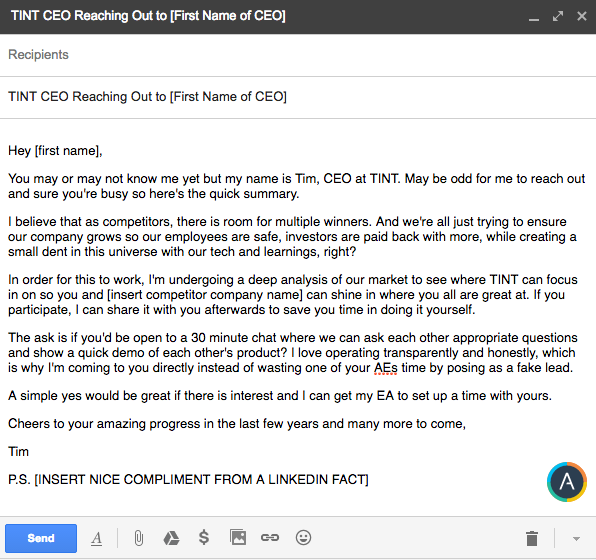TINT operates in a crowded space. Last I counted, we have around 24 competitors—a majority indirect and newly launched. I rarely pay attention to them, so that I am not distracted or tempted to copycat.
But when our company looked to me for answers on how we could differentiate from the noise, we could take one of two paths:
- Raise millions of dollars from VCs and approach the market as winner-take-all.
- Dig into competitor data to find the gap.
Anyone who knows me should know I went with No. 2. Raising money doesn’t solve problems—real revenue from sales does. And in some markets, like content marketing, there aren’t multiple winners.
Even using millions of data points extrapolated from our competitors, there’s one big problem: data accuracy. With the stakes high for using correct data, I could steer the company in the wrong direction. And so I went with the main source of company data: the CEO.
I know that CEOs can lie, especially when money or success is on the line. You know how your BS meter can go off when sharing a “core differentiator” to a customer or investor? If so, this post will help you find the data you need to be confident with your differentiation with a different strategy.
I’ll share my end-to-end experience so that you can replicate it and discover your core differentiation in a multiple-winner market.
To maximize results, it’s best if you meet these qualifications:
- You’ve been in the same market for at least two years—signaling to your competitors that you’re a “legitimate startup.”
- You don’t operate in a winner-take-all market (read examples at Quora).
- You’re so confident in your business model and product that you’re willing to share some secrets.
Process
To align your prospects, your team, and—most important—yourself, define a goal.
For TINT, our goals were to:
- Understand TINT’s differentiation.
- Build relationships with CEOs of competitors.
- Get a pulse on what’s going on in the market space
2. To figure out whom to target for your analysis, define your prospects.
Not all of your targets should be competitors, or you’ll end up with noise and false positives. Find companies that you’re most compared to by your market and customers. I chose nine from which our clients moved or we were most stacked against for big deals.
3. Use Google and LinkedIn to get the right CEO contact info.
Search the company name + “CEO” + “LinkedIn” to get the right name to target. Then use my simple email hack to reveal their email addresses. It took me about 20 minutes for all nine companies.
4. Now, draft your email.
Be strategic—get to the point and inspire them to share accurate data. Be honest, call out the BS, and practice vulnerability. Remember: A competing CEO is just another human who invests every ounce of his or her intelligence to create success.
Here’s my email that generated seven successful responses—an 80% success rate!

5. Book your meetings and set the agenda.
Nobody likes aimless meetings—use your time to shine by asking only those questions that will help define your differentiation. Allow the CEO to decline answering a question or share others they want answered. Make sure that both of you are comfortable with all questions.
These were the questions I asked:

6. Finally, have a genuine conversation.
- Start by saying how much you respect how far they’ve taken the company, or even what you like about it—its values, products, etc. We all like our hard work to be recognized.
- Remind them of their choice to decline answering any question.
- Ask the question, but first answer it yourself. The more you share, the more they will too. Resulting in more data points you can act on to discover core differentiation.
- Conclude the call with sincere gratitude, and tell them you’d like to stay in touch. Maybe prepare a fun question about something you saw about them on LinkedIn.
- If you really enjoyed the conversation, ask to meet up in person.
A Few Lessons
a. Not all competing CEOs are evil.
You know that feeling you get when a competitor swoops a deal away from you? Well, that happened so many times, I developed a negative perception of the competing CEO. But when I hopped on these calls to share our challenges and ideas, I heard they were just as scared about future unknowns. Feeling that vulnerability, we could give advice on what to avoid. How awesome!
I connected particularly well with a competing CEO who had a similar focus on growing the company by prioritizing culture and people first. That started a conversation on the next point.
b. Open up merger opportunities.
When speaking to your competitors, remember that you both know your market but have a unique way of capturing it. This is a perfect opportunity to think about future merger opportunities if it makes sense. You both want to ensure a growing company, right? And with an aligned vision and resources, opening that door with a conversation never hurts.
I connected so well with that one CEO that we regularly text. And the more we’ve gotten to know each other, the easier the conversations have become. Don’t necessarily expect such a result, but it can definitely happen.
c. Discover your company’s core differentiations.
The main reason you initiated this experimentation! After compiling and spending a few days with the data I gathered, I presented the findings to our team. You could see some serious excitement and alignment from this data.
I was able to discern two core differentiations and a few future opportunities to maximize.
- An educated, well-versed user is a profitable user. We saw an underserved gap in the SMB-SME market, whose marketers are not so technical. A drag-and-drop with copy+paste experience is what they expect, which we provide and will continue to make easier.
- We are profitable in two industries not served by our competitors. Our product can be used by hundreds of industries, but focusing on being the best in a couple is far better than trying to be half as good in many.
Closing Words
I took on this experiment to solve the challenge of discovering core differentiations in a startup. It may not be the best, most universal way. But it worked for us, bringing focus and opening up more opportunities than I had originally planned. If you’re excited or have questions, leave a comment below. If you tried it, I would love to learn more about your experience in the comments as well!
-Tim
CEO, TINT




![Give Your Audience a New Perspective With UGC + DAM Webinar with Widen [Summary, Slides, and Recording]](https://www.tintup.com/blog/wp-content/uploads/Screen-Shot-2018-09-14-at-1.52.14-PM.png)